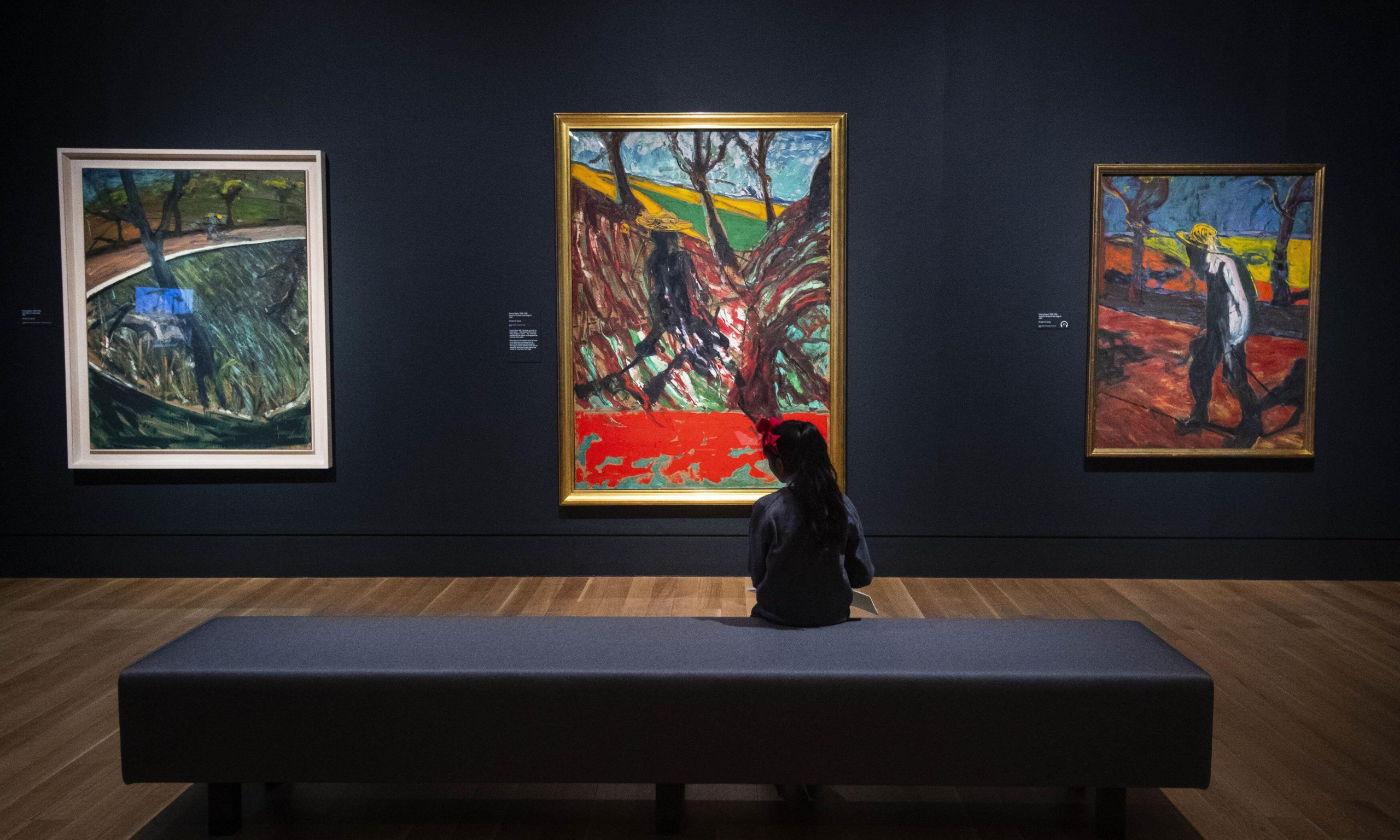Adventures with Van Gogh is a weekly blog by Martin Bailey, our long-standing correspondent and expert on the artist. Published every Friday, his stories range from newsy items about this most intriguing artist to scholarly pieces based on his own meticulous investigations and discoveries. © Martin Bailey
An anthology of writings on Francis Bacon compiled by Michael Peppiatt, to be published next month, includes revealing comments on Van Gogh. Bacon (1909-92) was a great admirer, inspired to produce a series of bold paintings capturing the Dutch artist striding off to work in the Provençal countryside.
Francis Bacon’s paintings in the last room of Tate Britain’s 2019 exhibition Van Gogh and Britain. Hanging (left to right): Van Gogh in a Landscape (1957, Centre Pompidou, Paris), Study for a Portrait of Van Gogh VI (1957, Arts Council England, London) and Study for a Portrait of Van Gogh IV (1957, Tate, London).
Photo: Alamy; Paintings: © Francis Bacon Estate
In Francis Bacon: A Self-portrait in Words (Thames & Hudson), Peppiatt records statements by the artist. Bacon told Peppiatt that having read Van Gogh’s letters over and over again, he recalled his memory of some of the Dutchman’s words: “What I do may be a lie, but it conveys reality more accurately.”
Bacon had then added his own comment, “it’s not the so-called ‘realist’ painters who manage to convey reality best”. Bacon certainly practiced what he preached, producing disturbingly distorted images of his models.
Francis Bacon’s own copy of himself by John Deakin (around 1962)
Photo: © John Deakin, Estate of Francis Bacon
In his anthology Peppiatt also includes a 1973 interview Bacon gave to the art historian Hugh Davies. Bacon told Davies: “All art is a lie… Van Gogh… deformed appearance all the time to make it more real… If you are going to make a portrait of somebody, how are you going to deform the image so profoundly and return it to fact?” Bacon went on to say that two painters had successfully achieved this by putting paint on “in slabs”: Cézanne and Van Gogh.
In 1956-57 Bacon had made a series of pictures inspired by Van Gogh’s The Painter on the Road to Tarascon, a lost 1888 work which was probably destroyed during the Second World War. Owned by the art museum in Magdeburg, in central Germany, it was stored deep in a salt mine to protect it from bombing. But in April 1945 there was an underground fire and it is feared that the Van Gogh was burnt.
Van Gogh’s The Painter on his Way to Work (The Painter on the Road to Tarascon) (August 1888), reproduced in Vincent van Gogh (Phaidon, 1936) The Art Newspaper
Bacon never saw the original of The Painter on the Road to Tarascon, but he had a pre-war colour reproduction—most likely the frontispiece in a 1936 Phaidon volume on Van Gogh.
Throughout his career Bacon often worked from photographs, using them as a jumping off point for his vivid imagination. It is likely that he chose The Painter on the Road to Tarascon as his inspiration precisely because he had never seen the original—and it no longer existed.
Altogether Bacon produced nine major paintings inspired by the destroyed Van Gogh. Along with the three shown at Tate Britain in 2019, there are two works in the Hirshhorn collection in Washington, DC (Version III and Version V), one at the Sainsbury Centre in Norwich, one at the Museum für Gegenwartskunst (Contemporary Art) in Siegen (Germany) and two in private collections.
In Bacon’s depictions of Van Gogh struggling along the Road to Tarascon, burdened with his painting equipment and trailing a very dark shadow, it is tempting to see the tortured, standing figure as partly a self-portrait of the British artist.
Other Van Gogh news:
Van Gogh’s Head of a Peasant (January-March 1885) Sotheby’s
Sotheby’s is to auction Van Gogh’s Head of a Peasant (January-March 1885) in New York on 16 May, with an estimate of $1.5m-$2.5m. It is being sold from the estate of a Boston collector.
The painting almost certainly depicts Gordina de Groot, who appears in a number of Van Gogh’s peasant “heads” produced in the Dutch village of Nuenen. In Van Gogh’s other pictures of de Groot, she mainly appears against a dark background, but in the Sotheby’s picture she is shown in a light blue-green setting, giving the composition an airy feel with a focus on her profile.
Head of a Peasant has not been on view since 1990, when it was briefly on loan to New York’s Metropolitan Museum of Art.
Martin Bailey is the author of Van Gogh’s Finale: Auvers and the Artist’s Rise to Fame (Frances Lincoln, 2021, available in the UK and US ). He is a leading Van Gogh specialist and investigative reporter for The Art Newspaper. Bailey has curated Van Gogh exhibitions at the Barbican Art Gallery and Compton Verney/National Gallery of Scotland. He was a co-curator of Tate Britain’s The EY Exhibition: Van Gogh and Britain (27 March-11 August 2019).
Martin Bailey’s recent Van Gogh books
Bailey has written a number of other bestselling books, including The Sunflowers Are Mine: The Story of Van Gogh's Masterpiece (Frances Lincoln 2013, available in the UK and US), Studio of the South: Van Gogh in Provence(Frances Lincoln 2016, available in the UK and US), Starry Night: Van Gogh at the Asylum (White Lion Publishing 2018, available in the UK and US) and Van Gogh’s Finale: Auvers and the Artist’s Rise to Fame (Frances Lincoln 2021, available in the UK and US). Bailey's Living with Vincent van Gogh: the Homes and Landscapes that Shaped the Artist (White Lion Publishing 2019, available in the UK and US) provides an overview of the artist’s life. The Illustrated Provence Letters of Van Gogh has been reissued (Batsford 2021, available in the UK and US).
To contact Martin Bailey, please email [email protected]. Please note that he does not undertake authentications.
Read more from Martin's Adventures with Van Gogh blog here.

